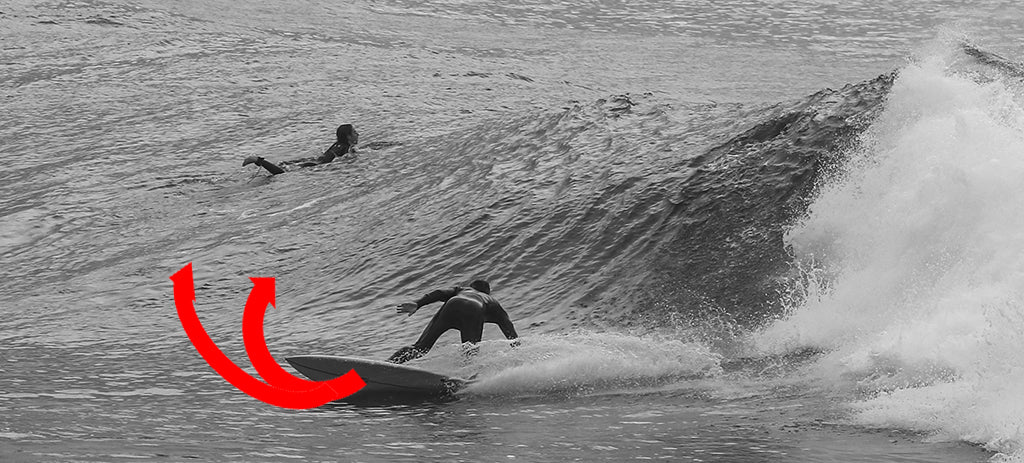How To Choose A Surfboard - Your Nose
In this article in our series How To Choose a Surfboard for you as a progressing surfer, we look at the nose of your surfboard

The nose is the part of your surfboard that is the most out of contact with the water. When you're paddling, catching and surfing your wave, most of the nose is sticking out of the water.
So why is it so important?

On your wave, paddling, and in fact most of the time when surfing your nose is out of the water. So why is the nose of your surfboard so important?
Your nose plays a vital part in how your board performs and its features are some of the easiest for you to identify on your surfboard. Noses can be wide or narrow, thick or thin, have flat or more rocker. So what do these different characteristics give to your surfing?
Wide Surfboard Nose

Wide Nose Benefits
Your wider nose has more area and volume. This creates momentum so once you start to paddle it tends to keep your board's forward momentum going.
This equates to easier wave catching and more glide on the wave.
A wider nose flows on to extra width in your board. So from your nose to where your chest is positioned over your board when paddling, the width helps spread your weight over more water surface.
You don't sink and slow, you can paddle well and fast. You can catch more waves, more easily, a key to rapidly progressing.
When standing and surfing on the wave, this extra width from your nose through your board continues to help distribute your weight, helping you surf over fat, flat and get around close-out sections.
Longboards and mals have wider noses, so adding a bit more width to your shortboard nose will give you some of their good paddling, wave catching and glide.
Extra width can also help you not catch or nose dive when taking off in smaller waves.
Wide Nose Problems

Wide noses are harder for you to duck dive. This is a real problem as the waves get bigger
Wide noses though have drawbacks.
Wide noses are harder to duck dive. As the waves get bigger it's harder to push your board under the wave and get through. If you can't get through the waves, or it's so taxing to get out the back, this reduces your ability to catch waves.
As the swell gets bigger, so do the lumps and chop on the water. A wider nose tends to get caught in these rather than more easily navigate between them.
If you're a Smaller surfer, too much width from the nose and through your board can hinder your ability to paddle, the paddling angle of your arms wrong because your board is too wide.
Extra width means extra volume and often extra weight. Too big and heavy a board, especially in small waves, will limit your performance.
Wide noses can add momentum when you're turning on the wave. This is called swing weight. When you do turns you can swing into and out of turns, the fuller nose helping swing you around making for power moves.
However swinging through the turn takes a few seconds of time, so it's not great for when you want to, or have to, turn fast or want to do powerful sharp turns. Some surfers though, like Occy, have used this extra swing weight to their advantage.

A wide nose paired to a narrow tail was a purposeful design of Kelly Slater
Another interesting case is to check Kelly Slater's Wizard Sleeve surfboard where Kelly added a wider nose onto a pin shaped narrow tail, shorter board.
This gave Kelly the benefits of extra paddling and wave catching, and because the board is short, the nose is closer to Kelly's centre of power so he was able to easily swing the wider nose around and do great turns.
A wider nose, even a little bit wider than what you're used to, will catch the wind when it's offshore. It can make a big difference hindering your wave catching, getting you caught up in the lip. To compensate you have to do a extra paddle or two down the face on takeoff, if the wave permits.
Narrow Surfboard Nose

Narrow Nose Benefits
A narrow nose is easy to duck dive, to push deep into and under the wave. It's easy to use the wave's own power to push you down and out the wave back so you don't get hammered even if the wave is breaking right on you. It makes it easier to get out the back so helps you catch more waves.

Check how deep underwater a narrow and thin nose board can go with very little effort. This equates to ease of duck diving, getting out the back more easily, faster, hence helping catch more waves
On the wave face, the narrow nose doesn't carry forward as much, but on a wave with more power this is not an issue as the wave is pushing you. With the power of the wave behind you the narrow nose whips in and out of turns. You can project the nose well above the lip and whip it around in dynamic surfing. The narrow nose is super responsive.
Narrow noses, in waves that are mid size or bigger, offer less area for the wind to catch, so you get good wave catching.
As mentioned, in smaller surf they're not as easy for wave catching as the wider nose. However with less volume and weight, narrow nose boards tend to be easier to handle in all conditions.

Narrow nose, how about no nose. Feedback from surfers who've ridden boards with no nose is that they go great on the wave
Some manoeuvres use the narrow nose, like a through-the-lip re-entry, where you punch your nose through the lip and the wave brings you back around.
Some boards have no nose and surfers who've used them have feedback that they're great to surf on the wave. Kelly Slater has worked closely with one of the main Shapers who's was an advocate of no-nose boards, however Kelly did not adopt it and neither have any of the surfers at the World Tour level.
Thin Noses
Thinness is good for both wide and narrow noses.
In small to above normal size waves a nose that's thin as well as wider gives you the wide nose benefits without being unweildy.
If your nose is narrow and thin, the front of your board will be super responsive. You can more easily throw your board into big manoeuvres.

Thick nose on the left versus thin nose on the right. Both have their best performance in different wave conditions. Check how the nose on the left has a very rapid increase in thickness as you progress down the board
Thick Noses
Thick noses, while not used anywhere near as much as thin noses, have a place. Thick, and narrow, noses add momentum without area. So you get momentum for paddling and wave catching, without extra area getting caught in the wind or chop.
For waves of consequence, that are solid and bigger, thicker nose momentum will help you get into and down the wave. It will help you flow and drive in your turns.
Shorter retro style boards can have a big thick nose, a beak nose or similar. These boards tend to track in a straight line in small surf and are harder to turn.
Surfboard Nose Rocker

The one single thing that can make your board a failure. The nose at the top has around 20% less rocker than the nose below it. This equates to more forward speed but if all things are equal, such as the tail rocker, then the top board will not perform carving turns as easily. You can see the bottom nose is also thinner meaning it will be more responsive
While a wide or narrow nose is relatively easy to visually determine, nose rocker is not as immediately obvious.
Nose rocker is the amount your nose curves up from the flat. The nose rocker is also called nose entry.
You need a trained eye to compare the nose of boards. A tip is to place them side by side on the floor, without fins, and check rocker with a tape measure.
Nose rocker refers to the curve of the bottom of your board from under your chest to the tip of the nose. However, some noses have a tweak at the end making them seem to have even more nose rocker.
Nose rocker makes a big difference to how your surfboard performs. It is likely the one single thing that if done incorrectly will make your surfboard a failure.
Flatter Nose Rocker

The red arrows indicate how more nose rocker can help you do short arc turns in the power section of the wave. Flatter rocker tends to direct you out onto the shoulder. As a progressing surfer you want to be doing big turns wherever possible on a wave
If the nose of your board is closer to flat, this flatter rocker gives you speed in all wave types.
It paddles better, faster, water passing under the gradual curve more readily with each stroke. On the wave it's fast for the same reason, the water flowing easily, speedily.
The drawback is that the flattness doesn't fit in as well with the curve of the wave face. When you go to turn up or down the wave the front of your board can catch or have resistance in the wave's curve.
A way to compensate is to put your weight back on your tail as you do a turn so your nose sticks out of the water. This works if your nose isn't too flat.
Flatter nose boards can be very fast, in some cases too fast forcing you to go out on the shouler, or around sections rather than helping you perform turns.
More Nose Rocker
Boards with too much nose rocker will be hard to catch waves, their pronounced curve pushing water. Paddling can be painful and slow. On the wave you might get a good takeoff then feel your board slow, that it's sluggish and won't go forward.
It doesn't take too much nose curve to make bad nose rocker and a bad surfboard.
However more nose rocker is what you need to progress.
Having more nose rocker, and getting it right, can give you a very special board. The right nose rocker will catch waves, just a little less easily than a flatter nose. On the wave face it will help you turn and do powerful big manoeuvres in the pocket of the wave.
More nose rocker gives you control. You can surf the wave and surf with high performance. You can do what you want on the wave, rather than what the wave limits you to do.
How Does It All Come Together For You?

Match your nose characteristics to your boards for different waves. From left: a wider thin nose with flatter rocker works great in smaller waves; next, a medium width mid thickness nose with a little more nose rocker is great for your all round surfing; on the right, a narrower slightly thicker nose with more rocker is what you need for bigger heavier waves
The image above and caption sums up how you can utilise the different nose characteristics to rapidly improve your performance.
There's also another personal characteristic that plays a part.
You may have heard surfers described as Front Footed or Back Footed. This means that at times on the wave, like when doing a bottom turn, you tend to put your weight more over and drive from your front foot. Or you tend to lean back with your weight over your tail and turn with your back foot.
Although there's conjecture among the world's top Shapers whether there is such a thing, as all turning is meant to come from your back foot with your front foot providing balance, it's fair to say that at different times on the wave a surfers weight is switching from being over the front foot to the back foot where it's primarily meant to be.
If you tend to put weight forward you may perform best on a board with more nose rocker as your board will curve and drive into the wave as you lean forward putting it into turns.
If you tend to put your weight back you may like less nose rocker, turning from your tail rocker.

There's shaping tweaks to give you the best of a wide and narrow nose, and a flat and rockered nose. On the left, the nose width can be tweaked with a subtle curve just before the tip, maintaining then reducing width. On the right, your rocker can be flatter then tweaked at the tip so you get speed and an assist not to nose dive
You still need to paddle well and catch waves so it's vital to get good nose rocker - whether your nose is flatter or rockered.
If you're not yet sure of your personal preferences in nose rocker here's a few tips.
For you as a progressing surfer, you should be wanting to do more turns wherever the wave permits. So a board with more nose rocker would be better than too flat.
In your shorter small wave board go with flatter nose rocker and a slightly wider, thinner nose. This will give you a good wave catching board, fast on the wave face.
SURFit has Quiver Packs of 3 boards so you can get a set of boards with nose rocker and other attributes customised for you to match the common wave conditions you face so you can progress fast and always be surfing at a high level
For your mid size board go with less nose width, with a touch more nose thickness and rocker. This nose will aid your wave catching and you'll still have a responsive board.
For your Step Up, go with even less nose width, a bit more thickness and a touch more rocker and tweak at the nose tip. This will help you not to nose dive and help you get into solid waves. The extra nose rocker will help you do carving power turns utilising the power of the wave.
As you progress you'll find you'll have not just different boards for different wave sizes, but several boards for the same wave size - one will be for sucky waves with more nose rocker, the other for fuller waves with less nose rocker.
Great nose rocker with all factors tailored to your style and ability come together in your SURFit surfboard design. Perfect to progress your surfing.





